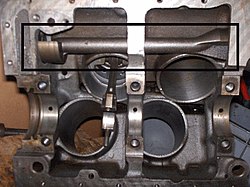Ford Taunus V4 engine

(This engine's balance shaft gear has its teeth stripped due to worn balance shaft bearings, a known problem of this engine.)
The Taunus V4 was a V4 piston engine with one balance shaft, introduced by Ford Motor Company in Germany in 1962. The German V4 was built in the Cologne plant and powered the Ford Taunus and German versions of the Granada, Capri and Transit. It is sometimes considered not to be a 'true' V engine as two opposing pistons do not share a crankpin on the crankshaft.
The V4 was later expanded into the Ford Cologne V6 engine that was used in the Ford Capri, Ford Taunus, Ford Cortina, Ford Consul, Ford Granada, Ford Sierra, Ford Scorpio, Ford Ranger, Ford Explorer and many other cars. The V4 engine was (and still is) also used in industrial applications: pumps, electrical generators, and in agricultural machinery. In automobiles, the Taunus V4 was replaced by the Ford OHC/Pinto engine.
Applications:
- Ford Taunus
- Ford Granada
- Ford Transit
- Ford Capri
- Saab 95
- Saab 96
- Saab Sonett (II-V4 and III)
- Matra 530
1.2
The 1.2 L (1183 cc) version features an 80.0 mm bore (3.15 inch) and 58.86 mm (2.3 in) stroke. Output was 40 hp (29 kW) and 80 N⋅m (59 lb⋅ft) or 45 hp (33 kW) and 82 N⋅m (60 lb⋅ft).
Applications:
- 1962 - 1966 Ford Taunus 12M P4
- 1967 - 1968 Ford Taunus 12M P6
1.3

The 1,3 L (1288 cc) version had an 84.00 mm (3.3 in) bore and 58.86 mm (2.3 in) stroke. Output was 50 hp (37 kW) and 95 N⋅m (70 lb⋅ft) or 53 hp (39 kW) and 98 N⋅m (72 lb⋅ft).
Applications:
- 1966 - 1970 Ford Taunus 12M P6
- 1969 - 1972 Ford Capri
1.5

The 1.5 L (1498 cc) V4 had a 90.0 mm bore and 58.86 mm (2.3 in) stroke. It produced 55 hp (40 kW) and 107 N⋅m (79 lb⋅ft), 60 hp (44 kW) and 114 N⋅m (84 lb⋅ft) or 65 hp (48 kW) and 117 N⋅m (86 lb⋅ft) at 2500 RPM.
Applications:
- 1962-1966 Ford Taunus 12M P4
- 1966-1970 Ford Taunus 12M P6
- 1966-1970 Ford Taunus 15M P6
- 1964-1967 Ford Taunus 17M P5
- 1967-1971 Ford Taunus 17M P7
- 1969-1972 Ford Capri
- 1967-1980 Saab 95 and Saab 96 (European market)
- 1967-1974 Saab 95, Saab 96 and Saab Sonett (USA market)
- The 1962 "Mustang I" Concept car (tuned to 90 hp (67 kW))
Since the Saab 96 was used for rallying it was also tuned. In the rally versions it was bored and stroked to 1784 cc and 1933 cc giving around 150 hp (110 kW) in the naturally aspirated version and 200 hp (150 kW) DIN at 7000 rpm in the Saab 96 RC Turbo version, doing 0 to 100 km/h (62 mph) in five seconds. SAAB also tuned the engine to 240 hp.[1]
1.7
The 1.7 L (1699 cc) V4 had a 90.0 mm bore and 66.8 mm stroke. It produced 65 hp (48 kW) and 129 N⋅m (95 lb⋅ft), 70 hp (52 kW) and 137 N⋅m (101 lb⋅ft) or 75 hp (55 kW) and 130 N⋅m (96 lb⋅ft).
Applications:
- 1966-1970 Ford Taunus 12M P6
- 1966-1970 Ford Taunus 15M P6
- 1964-1967 Ford Taunus 17M P5
- 1967-1971 Ford Taunus 17M P7
- 1965-1972 Ford Transit Mark I
- 1967-1972 Matra 530
- 1969-1972 Ford Capri
- 1972-1975 Ford Consul (German version)
- 1975-1981 Ford Granada (German version)
- 1971-1974 Saab 95, Saab 96 and Saab Sonett, low compression version with 55 hp (41 kW) (same as its contemporary 1500 cc 95/96) for USA market
Also, some DKW Munga, a Jeep like vehicle used in the German army were retrofitted with this Ford V4, to replace its standard two stroke engine.
Since the engine mounts and gearbox connections are identical between the Ford Cologne V6 engine and the V4, some vintage V4 Saab 96s were modified to take a V6, for rally racing, although this dramatically changed the weight distribution and steering characteristics.
